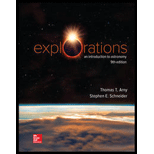
Concept explainers
The three main types of galaxies and find the galaxy differ in their shape, stellar content, and interstellar matter.
Answer to Problem 1QFR
The three main types of galaxies are spiral, elliptical, and irregular galaxy.
The elliptical galaxy are elliptical in shape, it is formed through galactic collision. It has little star formation; there is no interstellar medium.
The spiral galaxy are spiral in shape, it is formed through collision of smaller galaxies. It has rotating flat disc of star, dust and gases. It has large amount of interstellar medium.
The irregular galaxy does not have specific shape; it is formed through external gravitational disturbances. They have large amounts of interstellar medium.
Explanation of Solution
Elliptical galaxy:
Elliptical galaxy formed through galactic collisions. Thus the elliptical galaxy contains between 10 million to 100 trillion stars.
Elliptical galaxies contain metal rich stars that appear orange and red in color. It has no interstellar medium and thus it has very little star formation.
Spiral galaxy:
Spiral galaxies have two or more windings from the center. These galaxies contains mixture of young and old stars, because to make a young star, a galaxy must contains dense clouds of dust and gas
Spiral galaxies have 15% of mass in their disk in the form of interstellar matter,
Conclusion:
Irregular galaxy:
An irregular galaxy is a galaxy that does not have a specific shape. These galaxies are formed from external gravitational disturbance such as another galaxy passing near to it, it has large amount of interstellar medium.
Want to see more full solutions like this?
Chapter 17 Solutions
Loose Leaf For Explorations: Introduction To Astronomy
- Describe what a typical star in the Galaxy would be like compared to the Sun.arrow_forwardDescribe how you might use the color of a galaxy to determine something about what kinds of stars it contains.arrow_forwardWhen comparing two isolated spiral galaxies that have the same apparent brightness, but rotate at different rates, what can you say about their relative luminosity?arrow_forward
- There exists an element visible in the spectrum of galaxies that shows the following spectra when viewed in a sample at rest in the lab. At rest You obtain the spectra of four galaxies using a large telescope that look like the following. Galaxy 1 Galaxy 2 Galaxy 3 Galaxy 4 Match these galaxies to the corresponding locations on the Hubble diagram below.arrow_forwardHow astronomers determine the distance of a galaxy? Explain.arrow_forwardSuppose you have obtained spectra of several galaxies and have measured the observed wavelength of the H-Alpha line (rest wavelength = 656.3 nm) to be Galaxy 1: 658.1 nm. Galaxy 2: 667.1 nm. Galaxy 3: 677.6 nm. Calculate the radial velocity of each of these galaxies.arrow_forward
- Globular clusters revolve around the Galaxy in highly elliptical orbits. Where would you expect the clusters to spend most of their time? (Think of Kepler’s laws.) At any given time, would you expect most globular clusters to be moving at high or low speeds with respect to the center of the Galaxy? Why? (If you would like to learn more about globular clusters, read Section 22.2 of the book, though it is not necessary to answer this question)arrow_forwardWhat kinds of objects lie in the halo of a spiral galaxy? Globular clusters O and B stars Open clusters All typical components of a spiral galaxy (gas, dust, star clusters, O and B stars) Gas and dustarrow_forwardIdentify a feature of the Whirlpool Galaxy that is visible in all several types of light. Explain what this meansarrow_forward
 Stars and GalaxiesPhysicsISBN:9781305120785Author:Michael A. Seeds, Dana BackmanPublisher:Cengage Learning
Stars and GalaxiesPhysicsISBN:9781305120785Author:Michael A. Seeds, Dana BackmanPublisher:Cengage Learning AstronomyPhysicsISBN:9781938168284Author:Andrew Fraknoi; David Morrison; Sidney C. WolffPublisher:OpenStax
AstronomyPhysicsISBN:9781938168284Author:Andrew Fraknoi; David Morrison; Sidney C. WolffPublisher:OpenStax Stars and Galaxies (MindTap Course List)PhysicsISBN:9781337399944Author:Michael A. SeedsPublisher:Cengage Learning
Stars and Galaxies (MindTap Course List)PhysicsISBN:9781337399944Author:Michael A. SeedsPublisher:Cengage Learning Foundations of Astronomy (MindTap Course List)PhysicsISBN:9781337399920Author:Michael A. Seeds, Dana BackmanPublisher:Cengage Learning
Foundations of Astronomy (MindTap Course List)PhysicsISBN:9781337399920Author:Michael A. Seeds, Dana BackmanPublisher:Cengage Learning



